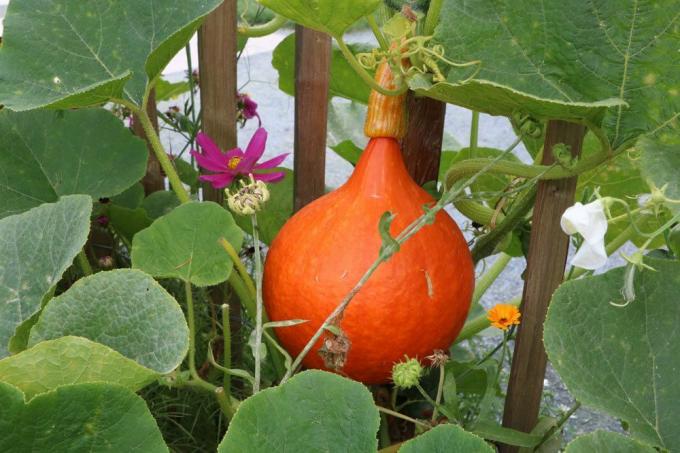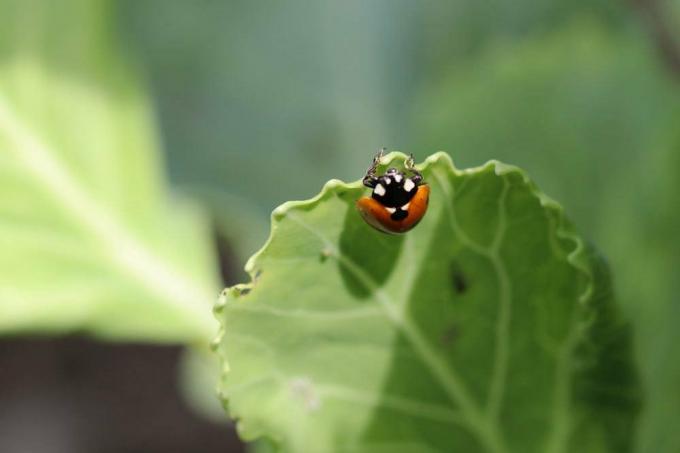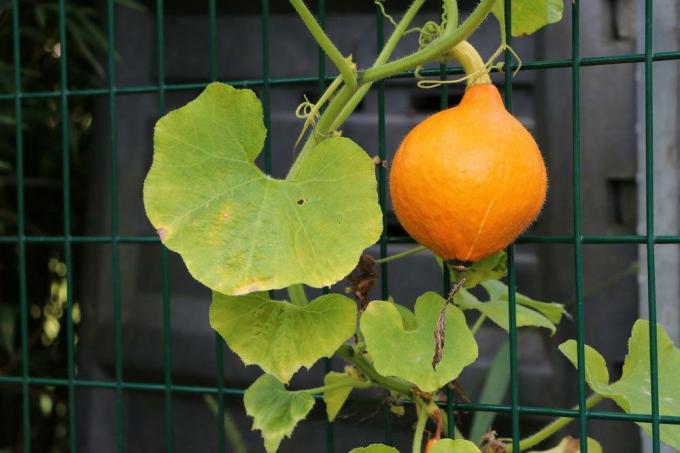
table of contents
- mildew
- Damage image
- species
- Prevent
- Combat
- Toxicity
- disposal
Powdery mildew is one of the most feared fungal diseases among hobby gardeners. And pumpkins are not spared from this either. So what should be done if the coating is discovered on the leaves or even on the fruits of the pumpkin plant? The control should take place immediately so that the harvest is not endangered. However, there are some means available for this which are also ecologically harmless.
mildew
Powdery mildew has a particularly characteristic damage pattern that usually immediately catches the eye. This is a fungus that can survive even cold temperatures in winter undamaged in the ground or on plants and weeds. If powdery mildew has been found in your own garden, it can occur again and again, even if it was successfully combated on the plants affected at the time.
Damage image
When the temperatures get warmer in spring, the mildew cells are transferred to the plants by host animals and the wind. At a temperature of 20 ° Celsius and high humidity, the spread in the garden begins explosively. A distinction is made between two types of powdery mildew. Therefore, if the white deposits on the pumpkin plants are under or already on the leaf side, then it can be real or downy mildew. So the infestation shows up as follows.

species
Powdery mildew
- white, floury spots on the top of the leaves
- on stems and fruits as well
- Leaves turn brown and die
- The cause is usually prolonged drought
- Warmth helps it spread
Wrong mildew
- whitish or brownish evidence
- look velvety
- are located on the underside of the leaf
- yellow to brown spots on the top
- usually shows up in very humid weather

Pumpkin breeds that are available in well-stocked gardening shops are often already resistant to powdery mildew. Therefore, if you have to take action against the annoying fungal attack in your garden again and again, you should buy one of the resistant varieties for the next season.
Prevent
Downy mildew always occurs when the area around the plant is moist or even very wet for a long time. Therefore, the pumpkins should not be watered too often or too much. The soil can be kept drier if some rock flour is mixed in with it. Fungicides should not be used with the edible pumpkins, as they could also be harmful to health if ingested. Fertilization with nitrogen should also be avoided at all costs, as this can promote an infestation with powdery mildew. In addition, the following can be done for prevention.

- vigorous pumpkin plants are more resistant to powdery mildew
- Strengthen plants with liverwort extract
- this also prevents the spores from multiplying
- Always water plants from below
- do not let water get on the leaves
- water only in the morning or in the afternoon
- especially in spring the plant should be dry at night
- Mulch on the ground makes pumpkins more resilient
Bacteria contained in cow's milk are intended to prevent powdery mildew infestation. For this, milk is mixed with water in a ratio of one to eight and sprayed regularly on the plants. The bacteria form a dense coating that does not harm the plants, but repels the pathogens of powdery mildew.

Combat
Fight biologically
The powdery mildew can be combated biologically without a chemical club on the pumpkin plants. But there are some agents that are environmentally friendly and easy to eat and can therefore be used at any time against powdery mildew on pumpkins.
- Plant mixed cultures
- to do this, place garlic between the pumpkin plants
- even basil and Tagetes keep the powdery mildew away
- Garlic as an infusion together with onion stock
- always choose an airy location
- Place plants at a sufficient distance
- Remove any infected parts immediately
- do not add to the compost
- Spray regularly with milk-curd soap-alcohol solution
- Use parasitic wasps and ladybugs

Parasitic wasps are available in well-stocked garden shops and can be used directly on the infested plants. Even if the insects are called wasps, they are in no way dangerous to humans or animals. Nevertheless, the bed with the pumpkins should be fenced off in such a way that it is not accessible to young children or those who run freely Pets can be entered so that they do not come into contact with any spores that may be on them can,
Use soda
Soda is already known as an all-purpose product in the kitchen, but it can also help against powdery mildew on pumpkin plants. If powdery mildew has already formed on the plants, soda can be used as a natural fungicide after the affected parts of the plant have already been removed. The mixture is then mixed as follows.
- a heaping tablespoon of soda
- alternatively, baking soda can be used in the same amount
- Dissolve in four liters of water
- Add 15 milliliters each of curd soap and vegetable oil

The mixture is poured into a spray bottle and the infested plants are sprayed with it several times. Also treat the soil around the pumpkins and neighboring plants if necessary.
Herbal broths against powdery mildew
Even mixed herbal broths usually also help against powdery mildew, because they activate the soil life and at the same time strengthen the defenses of the pumpkin plants. Field horsetail is used for this, which is available fresh or dried in well-stocked shops or in a farm shop on a farm. The preparation is therefore carried out as follows.

- 150 grams of dried field horsetail
- or a kilo of fresh herbs
- put in ten liters of water
- Leave to soak for 24 hours
- then let it cook for half an hour
- strain
- dilute with five times the amount of water for pouring
Regularly water the bed with the pumpkin plants with this brew; additional watering only with water is not necessary.
Toxicity
Powdery mildew harmful to health
If the pumpkin plants and perhaps even the fruits are attacked by powdery mildew, the question also arises as to whether this is harmful to health. It has been proven that powdery mildew can be poisonous, but this also depends primarily on the people who touch an infected fruit. Because powdery mildew can trigger allergic reactions if the gardener suffers from a fungal allergy. A penicillin allergy, as it occurs more often, can become very dangerous when it comes into contact with powdery mildew. Therefore, the following precautions should be taken with the powdery mildew infested pumpkins.

- do not eat infected plants
- Children and the elderly in particular should avoid this
- The consequences are stomach or digestive problems
- Difficulty breathing when breathing in the fungal spores
- Skin irritation after contact
- it is better to wear gloves and a respirator

disposal
Discard the infected pumpkin
If the pumpkin plants have been attacked by powdery mildew and rescue measures have already been carried out, but the powdery mildew persists, then these plants can unfortunately only be disposed of. For this purpose, the entire plants with the fruits should be removed from the infested bed. Please do not put these on the compost, because from here the fungal spores can spread throughout the garden. It is better to put the plants in plastic bags when they are removed, to close them tightly and then to dispose of them in the household waste. The bed also needs to be treated by removing the top layer of soil and throwing it away with household waste. Otherwise the spores can survive in the soil and infest the next plants again in the new season.
